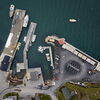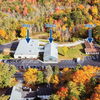Processing Your Payment
Please do not leave this page until complete. This can take a few moments.
- News
-
Editions
View Digital Editions
Biweekly Issues
- December 1, 2025
- Nov. 17, 2025
- November 03, 2025
- October 20, 2025
- October 6, 2025
- September 22, 2025
- + More
Special Editions
- Lists
- Viewpoints
-
Our Events
Event Info
Award Honorees
- Calendar
- Biz Marketplace
Editor's note: How oysters and potatoes find their way to our tables
In this issue, we delve into oyster growing and potato chip making.
Maine’s oyster “farming” sector has grown rapidly in recent years. Maine-grown oysters had a dock value of $14.8 million last year, and you can expect to pay quite a bit more at the oyster bar.
Mainebiz worked with one of our freelance photographers, Jim Neuger, to document the process of growing, harvesting and serving oysters.
In search of the best shot, Jim has braved foul balls and errant pucks to shoot baseball and hockey games. He’s climbed a ladder on the roof of the Time & Temperature building to get just the right angle. To light a photo shoot in an alleyway, he ran an extension cord from a nearby drug store.
There’s an old saying, “It took a brave man to eat the first oyster.” And it took a brave photographer to get out in a small skiff on a cold spring day — all in the name of documenting the Maine oyster trade.
Heading north, Aroostook County-based reporter John O’Meara looks at the construction of a 96,000-square-foot potato chip factory in Limestone.
Interestingly, while potatoes grown in the County are processed there for french fries and value-added meals, this will be the first potato chip factory in Aroostook. Up till now, the potatoes that would be turned into chips were sent to Connecticut to a Frito-Lay plant.
As John reports, there’s a logical reason for processing them closer to the source: Potatoes are largely water, so once they’re cooked they’re a whole lot lighter — and cheaper to transport. And one of the partners in the chip-making plant is also in the trucking business, so that’s what you call a win-win.
Mainebiz web partners
Related Content

The Giving Guide
The Giving Guide helps nonprofits have the opportunity to showcase and differentiate their organizations so that businesses better understand how they can contribute to a nonprofit’s mission and work.
Learn More
Work for ME
Work for ME is a workforce development tool to help Maine’s employers target Maine’s emerging workforce. Work for ME highlights each industry, its impact on Maine’s economy, the jobs available to entry-level workers, the training and education needed to get a career started.
Learn More
Groundbreaking Maine
Whether you’re a developer, financer, architect, or industry enthusiast, Groundbreaking Maine is crafted to be your go-to source for valuable insights in Maine’s real estate and construction community.
Learn more-
The Giving Guide
The Giving Guide helps nonprofits have the opportunity to showcase and differentiate their organizations so that businesses better understand how they can contribute to a nonprofit’s mission and work.
-
Work for ME
Work for ME is a workforce development tool to help Maine’s employers target Maine’s emerging workforce. Work for ME highlights each industry, its impact on Maine’s economy, the jobs available to entry-level workers, the training and education needed to get a career started.
-
Groundbreaking Maine
Whether you’re a developer, financer, architect, or industry enthusiast, Groundbreaking Maine is crafted to be your go-to source for valuable insights in Maine’s real estate and construction community.
ABOUT
NEW ENGLAND BUSINESS MEDIA SITES
No articles left
Get access now
In order to use this feature, we need some information from you. You can also login or register for a free account.
By clicking submit you are agreeing to our cookie usage and Privacy Policy
Already have an account? Login
Already have an account? Login
Want to create an account? Register
Get access now
In order to use this feature, we need some information from you. You can also login or register for a free account.
By clicking submit you are agreeing to our cookie usage and Privacy Policy
Already have an account? Login
Already have an account? Login
Want to create an account? Register










0 Comments